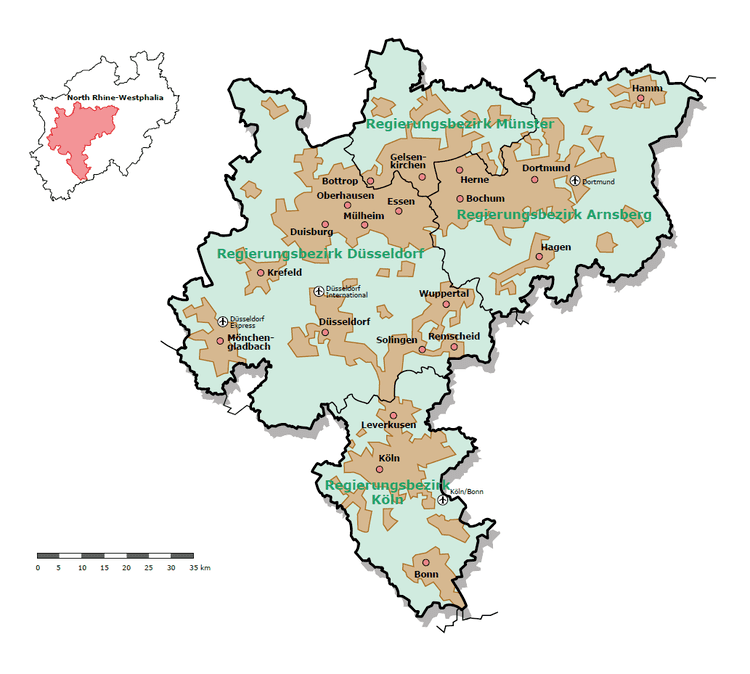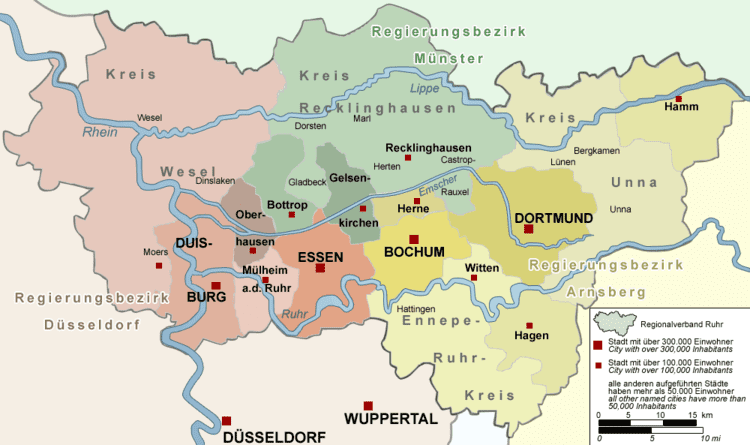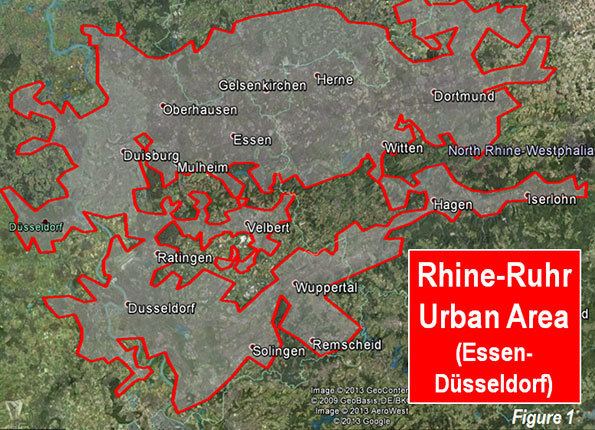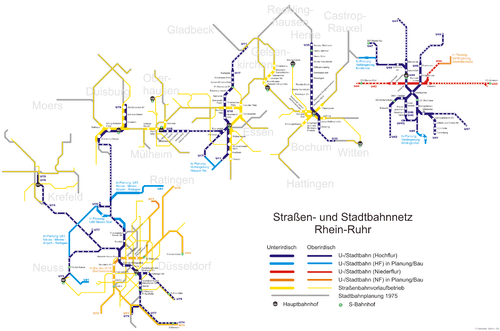Country State | Area 7,110 km2 | |
 | ||
Map of Rhine-Ruhr
The Rhine-Ruhr metropolitan region (German: Metropolregion Rhein-Ruhr) is the largest metropolitan region in Germany with over 11 million inhabitants. It is of polycentric nature and the only megacity in Germany. It covers an area of 7,110 square kilometers and lies entirely within the federal State of North Rhine-Westphalia. The Rhine-Ruhr Metropolitan Region spreads from Dortmund-Bochum-Essen-Duisburg (Ruhr Area) in the north, to the urban areas of the cities of Mönchengladbach, Düsseldorf (the state capital), Wuppertal, Leverkusen, Cologne (the region's largest and Germany's fourth largest city), and Bonn in the south. The location of the Rhine-Ruhr at the heart of the European Blue Banana makes it well connected to other major European cities and metropolitan areas like the Randstad, the Flemish Diamond and the Frankfurt Rhine Main Region.
Contents
- Map of Rhine Ruhr
- Rhineruhr
- Train by train without traffic through the rhine ruhr metropolis
- Subdivisions
- Economy
- Air
- Road
- Public transport
- Waterways
- Events
- Landmarks
- Museums
- Education
- Municipalities
- References

The metropolitan area is named after the Rhine and Ruhr rivers, which are the region's defining geographical features and historically its economic backbone.
Rhineruhr
Train by train without traffic through the rhine ruhr metropolis
Subdivisions

The largest cities in the Rhine-Ruhr area are Cologne, with over 1 million inhabitants, followed by Düsseldorf, Dortmund and Essen, which each have a population of over 500,000.

There are many different sub-definitions of what belongs to the Rhine-Ruhr area, but the metropolitan area itself has officially defined borders with Hamm in the east, Mönchengladbach in the west and Bonn in the south and the small city Wesel as its northernmost point. The northern border is similar to the border of the Ruhr Area.

The table below shows an unofficial summary of regions. In the official definition the metropolitan area is much smaller.

Eurostat's Urban Audit splits the Rhine-Ruhr region into six Larger Urban Zones (LUZ). These six Urban Zones do not cover the cities of Remscheid and Solingen nor the district of Rhein-Kreis Neuss.
Economy
Historically, most of the Ruhr area was for the most part characterized by heavy industry since the age of industrialisation in the late 19th and early 20th century. Since the Middle Ages, Cologne, Dortmund and other cities were important regional trading cities, but during the 19th century the city of Düsseldorf grew to become the administrative center of the region and since 1945 its political capital.
Today, the Rhine-Ruhr metropolitan region accounts for roughly 15% of the GDP of the German economy, which would place it as the 3rd largest GRP of metropolitan area in the European Union and the 16th largest GDP in the world. Despite this size, the Rhine-Ruhr region as a whole often lacks international competitiveness from the lack of a unified presentation, in which cities and urban areas within it, often pursue a separate investment policy against each other.
From within, Düsseldorf, Essen and Cologne are by far the largest economic centers, with specialisation in financial/high tech and insurance/multi media services respectively. Other major economic centers are Bonn and Dortmund. The region is home to twelve Fortune Global 500 companies, among them E.ON AG, Essen, Deutsche Post AG, Bonn, Metro AG, Düsseldorf, Deutsche Telekom AG, Bonn, ThyssenKrupp AG, Essen/Duisburg, RWE AG, Essen, Bayer AG, Leverkusen, Franz Haniel & Cie. GmbH, Duisburg, Evonik Industries, Essen, Hochtief AG, Essen and the Henkel Group, Düsseldorf.
Air
The area has four international commercial airports, and multiple smaller aerodromes for general aviation.
Road
North Rhine-Westphalia has the densest network of Autobahns in Germany.
Public transport
The rail, S-Bahn, U-Bahn and bus companies are administered through a consortium of local and regional transport lines, the Verkehrsverbund Rhein-Ruhr. It offers a rapid transit system which interconnects all cities and their respective local buses, trams, U- and S-Bahn systems, partly under the umbrella of Deutsche Bahn. Their systems are highly integrated where even some subway lines continue from one city to the next (for example between Düsseldorf and Duisburg or Bochum and Herne, which is unique in Germany, as the city border is crossed underground). The region is divided into several urban zones and fares are paid according to the amount of urban areas (or zones) passed through. Tickets include door to door transportation with all forms covered in one ticket with the exception of high speed rail (which only stops in the major cities). Some excursions, theatre and opera tickets as well as museums offer free transportation from any point in the Rhine Ruhr area to the venue and return.
Waterways
Duisburg Port (Duisport) and Dortmund Port are large industrial inland ports and serve as hubs along the Rhine and the German inland water transport system.
Events
The region is host to numerous large events, comprising fun fairs and cultural events like the Cologne and Düsseldorf carnivals (carnival is however a public event in almost all cities and towns of the area), the Cologne Comedy Festival, Ruhrfestspiele Recklinghausen, and the RuhrTriennale, as well as gamescom and other trade fairs at koelnmesse—Cologne Trade Fair and Messe Düsseldorf. With a capacity of up to 20,000 people, the Lanxess Arena and Westfalenhallen are amongst the largest indoor arenas in Germany.
The region is home to a total of 13 Bundesliga football clubs, of which five are active in the season of 2012/13. The most successful among them are Borussia Dortmund, Borussia Mönchengladbach, 1. FC Köln, FC Schalke 04 and Bayer 04 Leverkusen. Signal Iduna Park, the stadium of Borussia Dortmund, is the biggest stadium in Germany.
Landmarks
Several tourist destinations within the region attract over 12 million tourists per year. Cologne Cathedral, Augustusburg and Falkenlust Palaces at Brühl and the Zollverein Coal Mine Industrial Complex at Essen are UNESCO World Heritage Sites. Other sights include Schloss Benrath in Düsseldorf and several anchor points of the European Route of Industrial Heritage.
Museums
NRW Forum, Kunstsammlung Nordrhein-Westfalen, Kunsthalle Düsseldorf, Museum Koenig, Museum Ludwig, Romano-Germanic Museum, Wallraf-Richartz Museum, Neanderthal Museum, Museum Folkwang, Museum Ostwall, Lehmbruck Museum, German Mining Museum and Deutsches Museum Bonn are some of the most famous examples.
Education
The Rhine-Ruhr metropolitan region is home to nine universities and over 30 partly postgraduate colleges, with a total of over 300.000 students. The largest and oldest university is the University of Cologne (Universität zu Köln), founded in 1388 AD. Other universities include:
Municipalities
The following register lists all municipalities that officially belong to Rhine-Ruhr area. Demographically, these municipalities include 20 cities (German: ″Kreisfreie Städte″), each with more than 100,000 inhabitants, and 11 districts (German: "Kreis"), each with a population of more than 250,000 inhabitants. Some districts only belong partly to Rhine-Ruhr area. In such a case only the municipalities that belong to the Metro area are listed.
